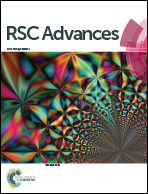Two AIEE-active α-cyanostilbene derivatives containing BF2 unit for detecting explosive picric acid in aqueous medium†
Abstract
Two novel α-cyanostilbene derivatives bearing triphenylamine and BF2 groups are synthesized (named TPE-B and TPE-BN). The fluorescent emissions of compounds TPE-B and TPE-BN are hypochromatically shifted and bathochromically shifted, respectively, with increasing polarity of the solvents, suggesting that the two compounds have characteristic polarity-dependent solvatochromic effects. Furthermore, they show obvious aggregation-induced emission enhancement (AIEE) phenomenon in THF/water mixture solutions. Meanwhile, compounds TPE-B and TPE-BN emit orange and yellow fluorescence in their solid states, respectively. Most significantly, in aqueous medium, compounds TPE-B and TPE-BN can selectively and sensitively detect picric acid (PA) among a number of nitroaromatic compounds, and their limits of detection (LOD) are calculated as 1.26 × 10−6 M and 1.51 × 10−6 M, respectively. The recognition mechanism for PA can be attributed to the photo-induced electron transfer (PET) process and this is supported by density functional theory (DFT) calculation. This research provides two novel compounds for the rational design of AIEE-active materials for sensing systems.



 Please wait while we load your content...
Please wait while we load your content...